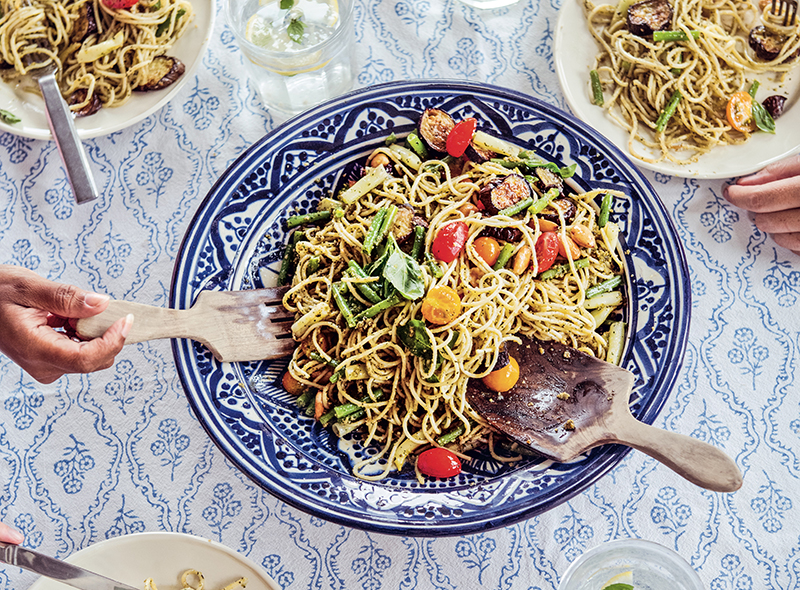"Many foods that were novelties only a decade ago are taken for granted now. Consider, for example, greens like arugula, radicchio and lamb’s lettuce or herbs like fresh coriander, chervil, ginger and basil, which I first encountered 20 years ago in a restaurant in Manhattan’s Little Italy. My lunchtime host recommended that I sample fettuccine with a basil-based sauce called pesto; it was love at first taste. For many Americans basil and other condiments entered the lexicon only recently—but with a vengeance signaling a major shift in culinary tastes from the provincial to the cosmopolitan."
—Craig Claiborne, “Culinary America: Food Fascination Sweeps the Nation,” The New York Times, January 1, 1986
This major shift in “culinary tastes” owes much to the Cuisinart and other food processors, which became essential kitchen products for pie crusts, hummus, and pesto in the 1970s. A great line in the late Nora Ephron’s 1989 movie, When Harry Met Sally, was: “Pesto is the quiche of the eighties.” And during this same period, when my children were young, Larry David and Jerry Seinfeld wrote “The Busboy,” a Seinfeld episode that aired June 26, 1991. George says, “Everybody likes pesto. You walk into a restaurant, that’s all you hear—pesto, pesto, pesto.” To which Jerry responds, “I don’t like pesto.” George has the last line: “Where was pesto ten years ago?”
When asked what their favorite recipe was while they were growing up, my children, now in their thirties and forties, invariably say pasta with pesto and string beans. I used to think they simply liked the alliteration of “p’s.” Nuts, basil, garlic, and pasta are just a great combination, one invented by the Genovese and made with gusto at home by Americans, in their food processors. (Most Americans would never have had the patience to use a mortar and pestle to grind the ingredients!) But a few years ago, when I tasted Pino Maggiore’s pasta with pesto at his restaurant Cantina Siciliana in Trapani, Sicily, I truly understood why it tastes so good. Pino, as he ground his pesto with a mortar and pestle into a chunky pasta sauce, dismissed the food processor, saying that it chopped too quickly, and provided no pleasure for the cook in the act of grinding. As a mother who knew her kids loved pasta but wanted to steer clear of macaroni and cheese for every meal, I found pesto a quick alternative. With the addition of green beans, I must admit it was and still is absolutely delicious. I now follow Pino’s addition of cherry tomatoes and fried Asian eggplant, and his substitution of almonds for the Sicilian pine nuts, which makes the dish much more affordable.
Try walnuts, almonds, pecans, pistachios, or pumpkin seeds instead of the pine nuts, or use dandelion greens or even nettles (blanched first to remove their sting) for the basil. My mom used to make a large batch and divide it among ice-cube trays, which she froze for future meals. A woman after my own heart.
From My Life in Recipes by Joan Nathan. Copyright © 2024 by Joan Nathan. Excerpted by permission of Alfred A. Knopf, a division of Penguin Random House LLC. All rights reserved. No part of this excerpt may be reproduced or reprinted without permission in writing from the publisher.
Serves 4 to 6
- 11⁄2 teaspoons kosher salt, plus 2 tablespoons for the pasta pot
- 1 pound (453 grams) Japanese eggplant, sliced into 1⁄2-inch rounds
- 4 cloves garlic
- Leaves and tender stems from 1 bunch fresh basil (about 2 cups)
- 1 cup (140 grams) blanched almonds
- 1 cup (236 ml) extra-virgin olive oil, plus more if needed
- 1⁄2 cup (50 grams) grated Pecorino, Romano, or Parmesan cheese
- Freshly ground black pepper, to taste
- 12 ounces (340 grams) busiate, or other pasta of your choice
- 8 ounces (227 grams) string beans, broccoli, and/or zucchini, cut into 1-inch pieces
- 1 cup fresh cherry tomatoes, halved
1. Sprinkle about 1⁄2 teaspoon of the salt over the eggplant slices, and let them sit in a single layer on a paper towel for about an hour.
2. To make the pesto: Put the garlic, all but a few leaves of basil, all but 2 tablespoons of the almonds, and 1 teaspoon of salt in a mortar or food processor. Slowly add 3⁄4 cup (176 ml) of the olive oil and all but a tablespoon of the cheese. Pulse just a few times in the food processor, or work the mortar with a pestle, to grind until the sauce is rich and crunchy, yet spreadable, and the nuts are grainy in texture and still slightly crunchy; add a little more oil if desired. Adjust seasonings to taste.
3. Blot the eggplant dry. Put the remaining 1⁄4 cup (60 ml) of the olive oil into a frying pan, and warm it over medium-high heat. Add the eggplant rounds, and cook until they’re golden on both sides. Drain them on paper towels, and sprinkle them with pepper to taste. Fry the remaining almonds until they’re golden; then drain them.
4. Bring a large pot of water to a boil, add the pasta with 2 tablespoons of salt, stir, and cook until al dente, stirring occasionally. When the pasta has been cooking for a minute or so, add the snipped beans, broccoli, and/or zucchini and cook until done, or steam the vegetables in a colander over the pasta and cook until they are both al dente.
5. Strain the vegetables and pasta, and transfer them to a bowl. Gently stir the pesto into the pasta and vegetables until everything is thoroughly combined. Sprinkle with the remaining tablespoon grated cheese, the remaining basil leaves, and the fried almonds. Decorate with the eggplant rounds and halved cherry tomatoes. Serve warm or at room temperature.







